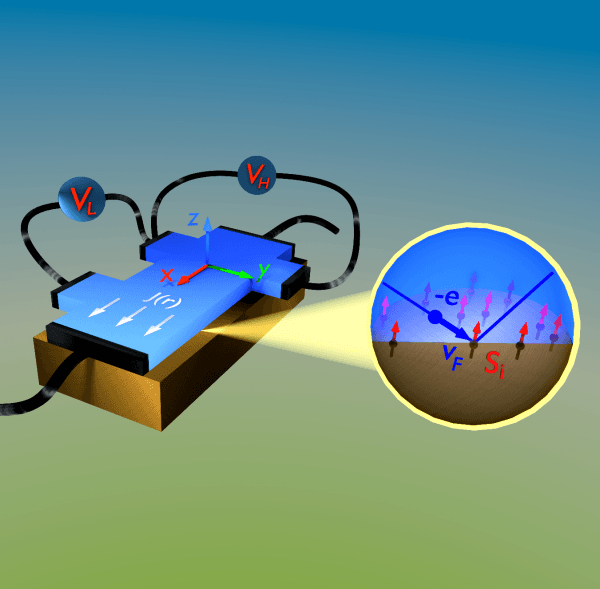Theory of spin Hall magnetoresistance from a microscopic perspective
In analogy to the ordinary Hall effect, the spin Hall effect (SHE) describes the spin-dependent deflection of electrons during transport in systems with strong spin-orbit coupling. Such a conversion of charge currents into transverse spin currents is employed now at the forefront of Spintronics to build a new generation of energy-saving electronics, exploiting the spin degree of freedom of the electron.
A manifestation of the SHE in a normal metal (NM) with spin-orbit coupling is the dependence of the magnetoresistance (MR) on the direction of the applied magnetic field when the metal is in contact with a magnetic insulator (MI), such as in NM/ MI structures. This effect, called spin Hall magneto-resistance (SMR), has been observed in several experiments as a modulation of the MR signal when the magnetization direction of the MI is changed by an external magnetic field. The origin of SMR lies in the electron’s spin-dependent scattering at the NM/MI interface. Thus, by changing the mutual angle between the polarization of spin current and the MI magnetization, one is able to modulate the rate at which the electron spin relaxes.
Although the SMR theory is well established and provides a good qualitative description of the effect, it does not describe the dependence of the resistivity on the strength of the applied magnetic field B, nor on the temperature T. The interface parameters, which are at the heart of the SMR effect, have traditionally been regarded as phenomenological ones in every experiment, because their computation was thought to be a formidable task, which could only be, carried out by ab initio methods.
“The theory presented in this work provides a tool to reveal by electric measurements the magnetic properties of interfaces”
Originally, the SMR was observed in Pt thin films deposited on the insulating ferrimagnet Y3Fe5O12 (YIG). Recent experiments explored other MIs and showed that the SMR effect depends strongly on both B and T, as well as on the magnetic state of the MI. A theory accounting for both the microscopic nature of magnetism in the MI and the spin dynamics of the conduction electrons in the NM near the interface was strongly desired.
In this work, a team from the Mesoscopic Physics Group with researchers from CFM and DIPC presents a general theory of the electronic transport in NM/MI structures. The spin-dependent scattering at the NM/MI interface is described via a microscopic model based on the exchange coupling between local moments on the MI surface and itinerant electrons in the NM. In this theory, the temperature and magnetic field dependence of the interfacial kinetic coefficients (such as spin-mixing conductance) is expressed in terms of spin−spin correlation functions in the MI.

Sketch of a Hall bar fabricated from a thin metallic film (blue) deposited on the surface of a magnetic insulator (brown). The electron scattering at the interface during which the electron spin interacts with local moments on the surface of the MI is at the heart of the SMR effect.

Different behaviors of the MR predicted by the microscopic theory for a ferromagnetic (a) and antiferromagnetic (b) exchange coupling between the localized moments of the MI and the conduction electrons in the NM. (c) Separation of the parameter space (dN, Gi) into different regimes of interest, with dN being the thin-film thickness and Gi the imaginary part of the spin-mixing conductance. The regions 1−4 correspond to the four kinds of behavior shown in (a) and (b). (d) Sketch of the spin accumulation µs at the thin-film interfaces as created by the SHE and altered by the SMR and HMR effects.
The theory presented in this work does not only explain experiments on a variety of magnetic insulators, such as YIG, EuS, and LaCoO3, but also provides a tool to reveal by MR measurements the magnetic properties of NM/MI interfaces. Furthermore, the theory predicts novel striking behaviors of the MR as a function of B-field, which can be understood in terms of an interplay between the SMR and the Hanle effects.



